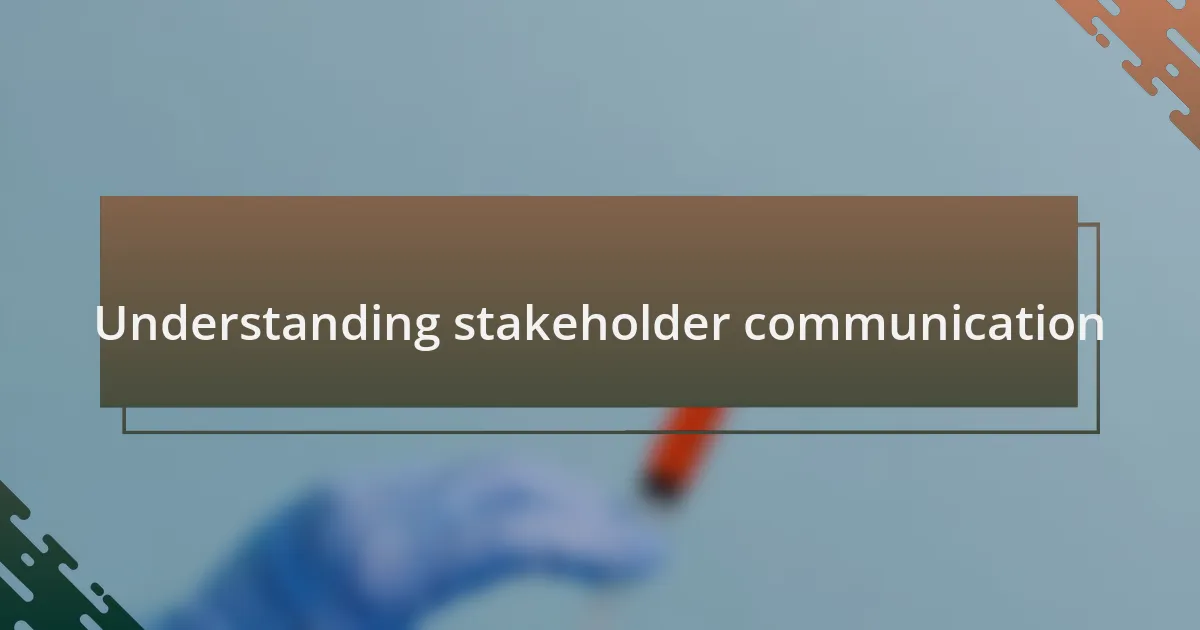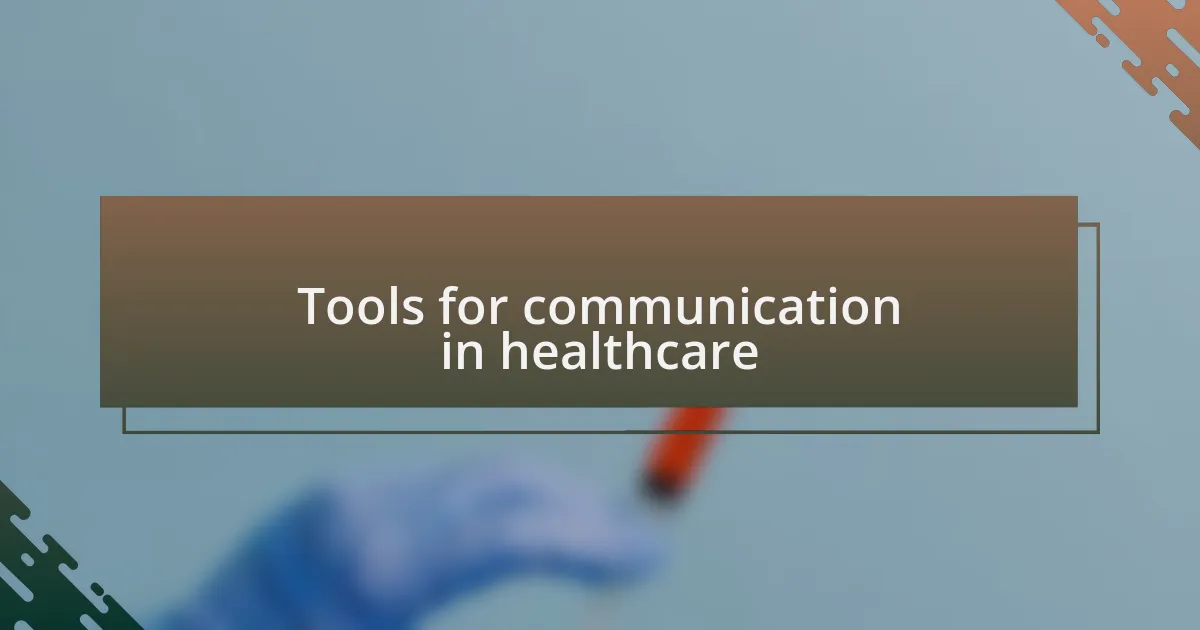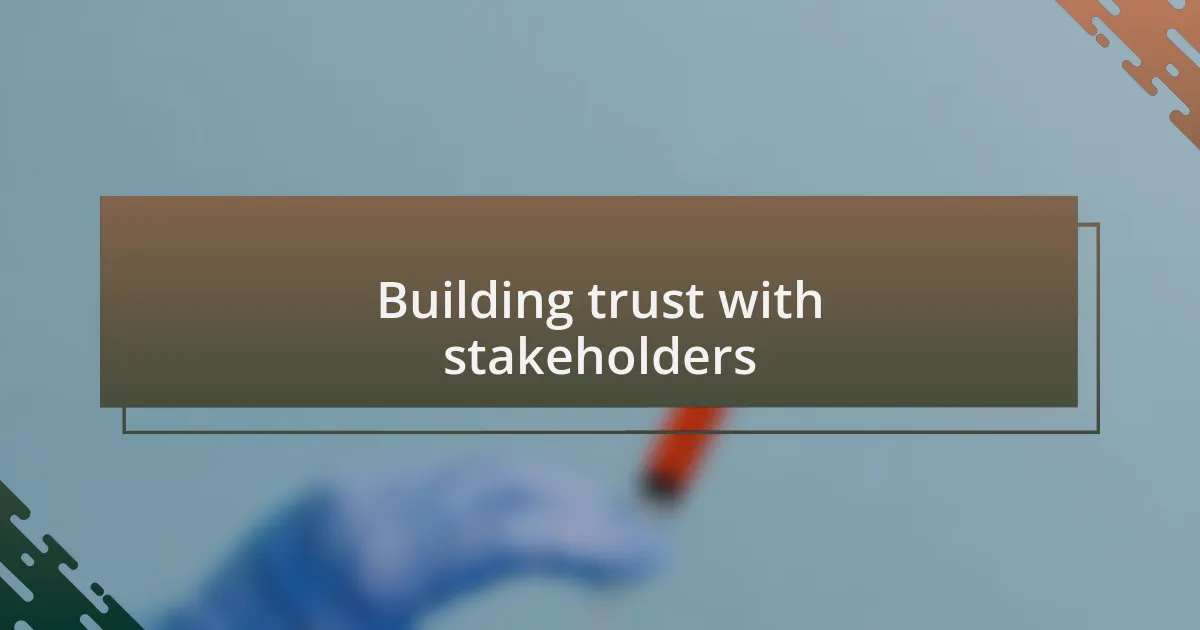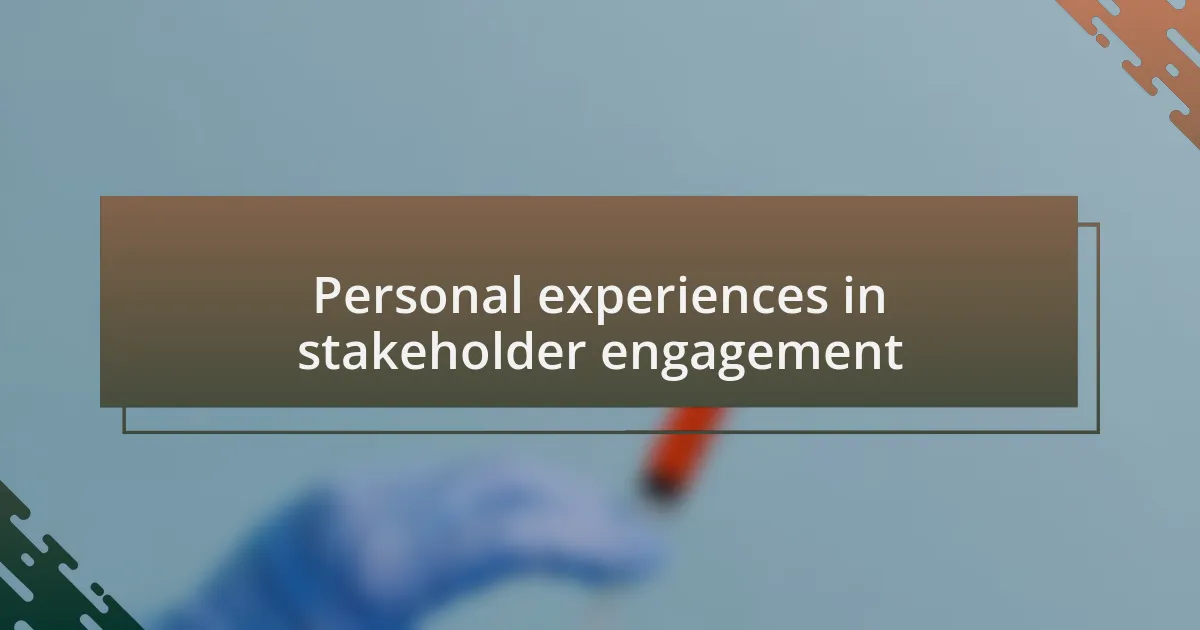Key takeaways:
- Effective communication in healthcare fosters trust, accountability, and collaboration among diverse stakeholders.
- Active listening and creating an inclusive environment are essential for meaningful stakeholder engagement.
- Using technology and tailored communication strategies can enhance stakeholder understanding and participation.
- Building trust through transparency and recognition of contributions strengthens relationships and project success.

Understanding stakeholder communication
Understanding stakeholder communication is crucial in any medical decision-making framework. I remember a project where I collaborated with doctors, nurses, and IT specialists. We often found ourselves speaking different languages, each from our own expertise. This experience taught me how vital it is to find common ground in our communication styles.
Effective communication fosters trust and transparency. I often ask myself: how can I ensure everyone feels heard? It’s essential to create an environment where each stakeholder can express their thoughts and concerns without fear of judgment. In my experience, regular check-ins and open dialogue not only clarify misunderstandings but also strengthen relationships among team members, making collaboration more fruitful.
Navigating the nuances of communication can feel daunting, especially in high-stakes environments like healthcare. I recall a time when I had to convey complex data to a diverse group, and I chose to use visual aids to bridge the gap in understanding. This small adjustment sparked engaging discussions and revealed insights I had overlooked. Isn’t it fascinating how a slight shift in approach can lead to such powerful connections?

Importance of effective communication
Effective communication serves as the backbone of collaboration in medical decision-making. I once worked on a team where a miscommunication led to a significant delay in a patient’s treatment plan. That experience underscored a crucial lesson: clear and direct dialogue is not just important; it’s essential for patient outcomes. Have you ever witnessed how a simple mix-up can have profound consequences? It’s moments like these that reinforce the need for a shared understanding among all parties involved.
Moreover, I can’t stress enough that active listening is just as important as speaking. During a project, I facilitated a meeting where each stakeholder was encouraged to share their perspective. The insights we gained from those discussions were often eye-opening, revealing different angles that I hadn’t even considered. How often do we assume we know what others think without truly hearing them out? This realization emphasized the importance of creating an inclusive environment where all voices matter.
The emotional tone of our conversations can also greatly impact stakeholder engagement. I remember a time when team morale dipped due to frustrations over a communication breakdown. By shifting our approach to be more empathetic and understanding, we not only resolved the conflict but also reignited our passion for the work we were doing. Isn’t it amazing how fostering a culture of empathy can transform the dynamics of a team?

Strategies for engaging stakeholders
I’ve found that tailoring communication strategies to fit the specific needs of stakeholders can really enhance engagement. In one instance, I created a visual presentation to explain complex medical data to a diverse group, which included both clinicians and non-medical professionals. The moment I saw their eyes light up with understanding, it reaffirmed my belief: sometimes, simplifying complex information is key to fostering collaboration.
Regular check-ins can also be a game changer. I recall implementing bi-weekly updates with a previous project team, where we would address concerns and celebrate milestones. This consistent touchpoint not only kept everyone informed but also created a sense of accountability and connectedness. Have you ever experienced how consistent communication can motivate a team? It certainly did for us, making us feel like we were all playing a pivotal role in the success of the project.
Finally, I always advocate for sharing personal stories linked to our work. On one occasion, I shared a story about a patient whose life was changed due to our collective efforts. The impact was palpable; it energized the team and reinforced our shared purpose. Isn’t it fascinating how personal anecdotes can bridge gaps and create a deeper emotional connection with stakeholders? By weaving these narratives into our communications, we can foster a more engaged and committed group.

Tools for communication in healthcare
In the realm of healthcare communication, utilizing technology can make a significant difference. For instance, I’ve found that project management platforms like Asana help keep everyone on the same page. When I first started using it for stakeholder updates, I noticed how quickly everyone responded to messages and action items, prompting more efficient follow-through.
I also believe in the power of teleconferencing tools like Zoom, especially when meeting in person isn’t feasible. During one project, I organized a cross-disciplinary meeting using video conferencing to connect with remote team members. The ability to see expressions and gestures added a layer of connection that emails simply cannot replicate. Have you ever felt that energy during a virtual meeting? It underscores how important visual interaction is in fostering collaboration.
Lastly, I often turn to collaborative document platforms like Google Docs for real-time input. It’s fascinating to witness how team contributions can shape a project document as everyone shares thoughts simultaneously. This method not only enhances communication but also invites diverse perspectives, enriching the overall quality of the work. Can you envision how empowered stakeholders feel knowing their insights are valued? I’ve seen it cultivate a sense of ownership in the team’s initiatives, ultimately benefiting patient care outcomes.

Building trust with stakeholders
Building trust with stakeholders in healthcare requires transparency and consistency. In my experience, when I openly share project timelines and updates, stakeholders feel more involved and less anxious about the process. I remember a time when I provided regular status reports to a group of concerned physicians; this not only alleviated their worries but also solidified their support for our initiatives. Have you ever noticed how openness can really change the dynamics of a working relationship?
Moreover, I find that actively listening to stakeholder feedback is crucial for nurturing trust. There was an instance when I implemented a new protocol based on a suggestion from frontline staff. The moment I acknowledged their input and acted upon it, I witnessed their engagement deepen, creating a more collaborative atmosphere. It’s astonishing how validating someone’s voice can make them feel valued, isn’t it?
Finally, I believe that sharing success stories fosters a deeper sense of trust. When I lead follow-up discussions post-project, I make it a point to celebrate milestones with the entire team. This practice not only recognizes everyone’s contributions but also reinforces a shared vision. Have you ever felt that sense of achievement when everyone comes together to reflect on their hard work? It’s these moments that strengthen bonds and elevate the commitment to future collaboration.

Personal experiences in stakeholder engagement
One of my most enlightening experiences in stakeholder engagement happened during a project aimed at streamlining patient intake processes. Early on, I realized the importance of bringing stakeholders into the conversation, so I organized a series of roundtable discussions. I distinctly remember the moment when a nurse candidly shared her frustrations. Her insights not only reshaped our approach but also made her feel integral to the process. Isn’t it amazing how a simple conversation can transform a project?
I also encountered a situation where I misjudged the level of concern among our administrative staff. Initially, I thought they would support our initiatives without much guidance. However, I learned the hard way that without regular check-ins and opportunities for input, they felt overlooked. When I finally scheduled bi-weekly updates, it was as if a weight had been lifted. It taught me that a little attention can yield strong alliances. Have you ever underestimated the power of simply asking for someone’s thoughts?
Another fascinating moment occurred when I collaborated with external partners for a new technology integration. At first, there were significant hurdles in aligning our visions. Instead of pushing forward unilaterally, I proposed a joint brainstorming session. The excitement in that room, filled with diverse perspectives, led to innovative solutions that none of us had considered before. It made me reflect on how collaboration can spark creativity. Have you had experiences where collaboration opened unexpected doors?